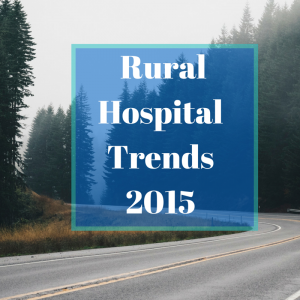According to the NC Rural Health Research Program there have been 56 rural hospital closures since 2010. The reasons behind the closures may vary but the message rings true, rural hospitals are struggling and something needs to be done. From difficulties implanting new HER systems to the re-evaluation of Medicare reimbursements, rural hospitals are looking for new ways to stay afloat. We’ve selected 4 trends that we’ve seen buzzing in the rural healthcare sector this year and that have been helping rural hospitals make the changes they need to succeed.
2015 Trends for Rural Hospitals and Rural Healthcare
1. Implementing EHR and Cloud Computing
Implementing EHR (electronic health records) systems has been on the rural hospital horizon for some time. The benefits are widely known: decreased travel times for patients, extended care access, and easier transfer of patients and data. It’s the challenges of implementing an EHR system such as cost, training, and available staff, that are much more difficult for rural hospitals to overcome. For this reason, as federal regulations regarding sharing patient and healthcare data digitally change, rural hospitals start to fall behind. This is where cloud computing comes in. Cloud based computing is storing data and information over the internet instead of on your actual hard drive. Cloud-based EHR systems are less costly, simpler to implement, and need less complex IT systems. Could cloud-based software be the saving grace for rural hospitals in 2015?
Here are three great resources that explore rural hospitals and EHR:
- Rural hospital EHR success story: https://www.clinicalkey.com/info/blog/rural-nebraskan-hospital-ehr-success-story/?doing_wp_cron=1439841489.8674480915069580078125
- Article on Cloud Based computing and Rural Healthcare: https://www.athenahealth.com/blog/2015/03/17/cloud-based-ehr-an-ideal-fit-for-rural-and-community-hospitals
- Cloud Computing White Paper: https://www.trubridge.net/sites/default/files/Cloud%20Computing%20Whitepaper.pdf
- A scoping review of cloud computing in healthcare: https://www.ncbi.nlm.nih.gov/pmc/articles/PMC4372226/
2. Shift to Care Coordination
Coordinating patient care is a big issue on the plates of healthcare organizations this year. The Agency for Healthcare Research and Quality defines quality care as “the deliberate organization of patient care activities between two or more participants (including the patient) involved in a patient’s care to facilitate the appropriate delivery of health care services.” Increasing effectiveness, efficiency, and safety are some of the main benefits of care coordination rural hospitals can reap. The white paper Realizing Rural Care Coordination by Robert Wood Johnson Foundation illustrates two important actions rural healthcare facilities can take if they’re thinking about care coordination. Those actions are: assembling “key stakeholders in rural areas and seek out partners in state government, and “survey the existing infrastructure of rural areas” (for example gaps in Health IT and staffing).
Here are some helpful resources on Care Coordination and Rural Hospitals:
- White paper on Care Coordination in Healthcare: https://ruralhealth.und.edu/projects/hwic/pdf/care-coordination.pdf
- Care Coordination in Rural Communities: https://www.safetynetmedicalhome.org/sites/default/files/Webinar-Care-Coordination-Rural-Communities.pdf
- Rural Care Coordination Toolkit: https://www.raconline.org/communityhealth/care-coordination
3. Musing on Mergers & Partnerships
With the roll-out of the ACA many rural hospitals are loosing their safety-net financing once provided though Medicare and Medicaid. The struggle then becomes how they stay open amidst financial turmoil. The USA Today article Rural Hospitals in Critical Condition, reported that “Low Medicare and Medicaid reimbursements hurt these
4 Helpful Resources:
- Rural Hospitals Mergers Study: https://www.shepscenter.unc.edu/product/rural-hospital-mergers-acquisitions-acquired-happens-afterward/
- “Hospital Mergers Produce Benefits, Not Costs”: https://fahpolicy.org/hospital-mergers-produce-benefits-not-costs-new-realignment-study-gains-national-media-attention/#sthash.aYLdLJUo.dpuf
- Opposing View Article: https://www.fiercehealthfinance.com/story/mergers-may-not-be-best-solution-rural-hospitals-woes/2015-02-08
- Rural Hospitals After a Merger: https://www.jhconline.com/rural-hospitals-after-a-merger.html
4. Turning to Telehealth
The growing importance of technology in healthcare can’t be denied. As many rural hospitals struggle to stay afloat new technology starts to play an important role in their survival. The Health Resources and Services Administration defines telehealth as “the use of electronic information and telecommunications technologies to support long-distance clinical health care, patient and professional health-related education, public health and health administration.” This can mean anything from videoconferencing, streaming media, wireless communication, to mobile applications. Telehealth opens a new channel of communication for rural hospitals. They can connect quickly to specialists and even meet with patients over video conferencing. Embracing telehealth could be a great step for rural hospitals trying to stay open.
Telehealth resources:
- Telepharmacy: https://www.ajhp.org/content/63/19/1776.full.pdf+html?maxtoshow=&HITS=50&hits=50&RESULTFORMAT=1&andorexacttitle=and&titleabstract=rural&andorexacttitleabs=and&andorexactfulltext=and&searchid=1&FIRSTINDEX=0&sortspec=date&fdate=9/1/2005&resourcetype=HWCIT,HWELTR
- Telehealth in Rural Communities: https://www.raconline.org/topics/telehealth
- Could telehealth help provide relief to Rural Hospitals: https://getreferralmd.com/2015/02/rural-hospital-closures-telemedicine-provide-relief/
- Telehealth and distance learning: https://www.americansentinel.edu/blog/2015/05/19/telehealth-and-distance-learning-can-help-rural-hospitals-face-challenges/
The important thing to member about rural healthcare systems is that what works for one system might not work for another. Keeping up to date with trends and rural hospital news helps keep everyone informed and can give insight into how to solve the issues rural hospitals face in the coming years.
Here are two very informative infographics focusing on the challenges rural hospitals and CAH face:
https://fahpolicy.org/?attachment_id=730#sthash.rOtu3AdJ.dpbs
https://www.aha.org/research/policy/infographics/critialaccess-hospitals.shtml

